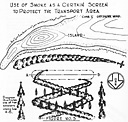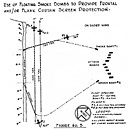| Plan ABLE |
|
(Not suitable if wind is north or easterly -- 350° to 110°T) |
| Run 1 - |
|
TBF smoker #1 drop 10 clusters of M77 HC
bombs in train at 150 ft. intervals, as indicated
by figures (1,1,1, etc.); approach in dive as though
on strike mission, drop from 1500 ft. Naval gunfire
observe plan VICTOR for target areas 9731 E and 9632 F.
If wind is southerly, move line of impact southwestward. |
| Run 2 - |
|
TBF smoker #2 drop clusters, after Run #1, along ridge as
indicated by figures (2,2,2, etc.) to cover upper part of
hill. If wind is southerly, the line of impact centers will
be shifted to southern side of ridge. Other procedures same
as for run #1. |
| Run 3 - |
|
TBF smoker #3, if specifically ordered to do so, reinforce or
extend the life of the screen, dropping bombs in positions indicated
by performance of smoke from earlier drops. |
| Plan BAKER |
|
(Not suitable if wind is westerly or northerly -- 260° to 70°T) |
| Run 1 - |
|
TBF smoker #1 drop 10 HC clusters as indicated, using same procedures
as in Plan ABLE, except that interval between clusters will be 300 feet. |
| Run 2 - |
|
TBF smoker #2 drop along line indicated, at intervals of 250 ft.,
making run simultaneously with smoker #1. |
| Run 3 - |
|
TBF smoker #3, if specifically ordered, reinforce or extend the
life of the screen, dropping bombs as for Run 1, unless performance
of smoke from earlier drops indicates that another position
is more desirable. |















